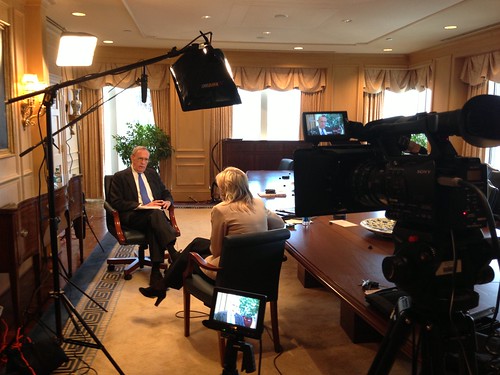I had the tremendous fortune to be a part of the interview process with The Duke Endowment, capturing the story from one of their Trustees. Mr. Russell Robinson is one of those Trustees and he has many stories to tell.
I walked away with a new perspective surrounding the legacy of the Duke Endowment and Mr. James Buchanan Duke. Mr. Duke was in the tobacco business establishing the American Tobacco Company in 1890, which becomes the largest tobacco company in the world.
“James B. Duke and his brother, Ben, work together in business and in philanthropy. Their sister, Mary Duke Lyon, is an early partner in the family endeavors. With the family’s influence and support, Trinity College opens a Durham campus in 1892. In 1896, the Dukes establish a $100,000 endowment for the school with the requirement that women be admitted ‘on equal footing with men.’ Later, Trinity College became Duke University.”
Mr. Duke was later forced to close the business in the early 1900’s. But, he had a vision of how he wanted to create a legacy for years to come.
His vision was to harness the power from the Catawba River and turn it into electrical power, using the proceeds from this business to fund initiatives that support the spirit, the education, and the health of North and South Carolina.
“Duke Energy began in 1900 as the Catawba Power Company when Dr. Walker Gill Wylie and his brother financed the building of a hydroelectric power station at India Hook Shoals along the Catawba River. In need of additional funding to further his ambitious plan for construction of a series of hydroelectric power plants, Wylie convinced James Buchanan Duke to invest in the Southern Power Company, founded in 1905.”
“They felt the South’s heavy dependence on agriculture was prohibiting growth of other industries. By developing an integrated electric system of hydro-powered generating stations, they envisioned linking customers by transmission lines – and creating new opportunities for economic growth.”
Mr. Robinson shared the history of The Duke Endowment and how it’s legacy was created through the income from Duke Energy. For many years, The Duke Endowment owned majority of the shares in now Duke Energy. They have slowly divested their interest over time, re-investing in other area of the market.
The goal was to provide the financial support to create a healthy, educated, spiritually connected community. You see this in the numerous benefitiaries that are supported by The Duke Endowment. From Duke University, Duke Medical, United Methodist Church to the three other institutions Johnson C. Smith, Davidson, and Furman along with numerous hospitals and other grantees carry out the vision Mr. Duke wrote in the initial Indenture of Trust.
Mr. Robinson spent hours sharing the vision and responsibility of the Board of Trustees, the burden to carry out Mr. Duke’s Legacy. Each year, the Board of Trustees reads Mr. Duke’s Indenture of Trust (his will) as a reminder of the vision they have been empowered to carry out.
Electricity has a lot to do with health. If you live in North or South Carolina, I would be willing to bet that your community hospital has been awarded or impacted by the financial support of Mr. Duke and The Duke Endowment. All this made possible by the first hydro-electric plant on the Catawba River. This flow of power has created a long term source of support that is invested in the future health of North and South Carolina.
Thanks to Mr. Robinson for sharing this story of legacy.
Here is a great video created a few years ago, the history of James B. Duke and The Duke Endowment.
*Sources: WikiPedia, Duke Energy, & The Duke Endowment

